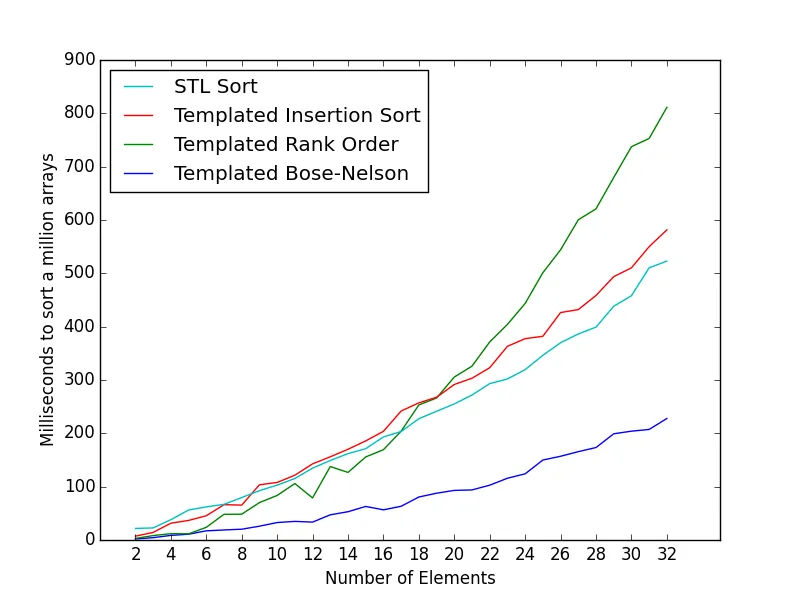这是一个小的类,它使用Bose-Nelson算法在编译时生成排序网络。
template <unsigned NumElements, class Compare = void> class StaticSort
{
template <class A, class C> struct Swap
{
template <class T> inline void s(T &v0, T &v1)
{
T t = Compare()(v0, v1) ? v0 : v1;
v1 = Compare()(v0, v1) ? v1 : v0;
v0 = t;
}
inline Swap(A &a, const int &i0, const int &i1) { s(a[i0], a[i1]); }
};
template <class A> struct Swap <A, void>
{
template <class T> inline void s(T &v0, T &v1)
{
T t = v0 < v1 ? v0 : v1;
v1 = v0 < v1 ? v1 : v0;
v0 = t;
}
inline Swap(A &a, const int &i0, const int &i1) { s(a[i0], a[i1]); }
};
template <class A, class C, int I, int J, int X, int Y> struct PB
{
inline PB(A &a)
{
enum { L = X >> 1, M = (X & 1 ? Y : Y + 1) >> 1, IAddL = I + L, XSubL = X - L };
PB<A, C, I, J, L, M> p0(a);
PB<A, C, IAddL, J + M, XSubL, Y - M> p1(a);
PB<A, C, IAddL, J, XSubL, M> p2(a);
}
};
template <class A, class C, int I, int J> struct PB <A, C, I, J, 1, 1>
{
inline PB(A &a) { Swap<A, C> s(a, I - 1, J - 1); }
};
template <class A, class C, int I, int J> struct PB <A, C, I, J, 1, 2>
{
inline PB(A &a) { Swap<A, C> s0(a, I - 1, J); Swap<A, C> s1(a, I - 1, J - 1); }
};
template <class A, class C, int I, int J> struct PB <A, C, I, J, 2, 1>
{
inline PB(A &a) { Swap<A, C> s0(a, I - 1, J - 1); Swap<A, C> s1(a, I, J - 1); }
};
template <class A, class C, int I, int M, bool Stop = false> struct PS
{
inline PS(A &a)
{
enum { L = M >> 1, IAddL = I + L, MSubL = M - L};
PS<A, C, I, L, (L <= 1)> ps0(a);
PS<A, C, IAddL, MSubL, (MSubL <= 1)> ps1(a);
PB<A, C, I, IAddL, L, MSubL> pb(a);
}
};
template <class A, class C, int I, int M> struct PS <A, C, I, M, true>
{
inline PS(A &a) {}
};
public:
template <class Container> inline void operator() (Container &arr) const
{
PS<Container, Compare, 1, NumElements, (NumElements <= 1)> ps(arr);
};
template <class T> inline void operator() (T *arr) const
{
PS<T*, Compare, 1, NumElements, (NumElements <= 1)> ps(arr);
};
};
#include <iostream>
#include <vector>
int main(int argc, const char * argv[])
{
enum { NumValues = 32 };
{
int rands[NumValues];
for (int i = 0; i < NumValues; ++i) rands[i] = rand() % 100;
std::cout << "Before Sort: \t";
for (int i = 0; i < NumValues; ++i) std::cout << rands[i] << " ";
std::cout << "\n";
StaticSort<NumValues> staticSort;
staticSort(rands);
std::cout << "After Sort: \t";
for (int i = 0; i < NumValues; ++i) std::cout << rands[i] << " ";
std::cout << "\n";
}
std::cout << "\n";
{
std::vector<int> rands(NumValues);
for (int i = 0; i < NumValues; ++i) rands[i] = rand() % 100;
std::cout << "Before Sort: \t";
for (int i = 0; i < NumValues; ++i) std::cout << rands[i] << " ";
std::cout << "\n";
StaticSort<NumValues> staticSort;
staticSort(rands);
std::cout << "After Sort: \t";
for (int i = 0; i < NumValues; ++i) std::cout << rands[i] << " ";
std::cout << "\n";
}
return 0;
}
基准测试
以下基准测试是使用clang -O3编译并在我的2012年中期Macbook Air上运行的。
对于排序1百万个数组的时间(以毫秒为单位)如下:
数组大小为2、4、8的毫秒数依次为1.943、8.655和20.246。

这里是6个元素小数组每次排序的平均时钟数。基准测试代码和示例可在此问题找到:
Fixed length 6 int array的最快排序
Direct call to qsort library function : 342.26
Naive implementation (insertion sort) : 136.76
Insertion Sort (Daniel Stutzbach) : 101.37
Insertion Sort Unrolled : 110.27
Rank Order : 90.88
Rank Order with registers : 90.29
Sorting Networks (Daniel Stutzbach) : 93.66
Sorting Networks (Paul R) : 31.54
Sorting Networks 12 with Fast Swap : 32.06
Sorting Networks 12 reordered Swap : 29.74
Reordered Sorting Network w/ fast swap : 25.28
Templated Sorting Network (this class) : 25.01
它在处理6个元素时与问题中最快的示例一样快。
用于基准测试的代码可以在这里找到。
它包含更多功能和进一步优化,以在真实数据上获得更强大的性能。

std::sort的差异相当小或几乎不存在。无论如何,为了测试速度,使用代码生成可能是最简单的解决方案(如果您不想出于学术目的而进行模板编程)。这里有一个类似的网站,它只输出一对数组以进行比较/交换,但我认为可以在5分钟内将其包装在C代码中。 - Damonstd::sort,然后使用分析器运行程序,看看它在该函数中花费了多少时间。也许std::sort也很聪明呢;) 当然,这个问题仍然很有趣。 - Shahbaz